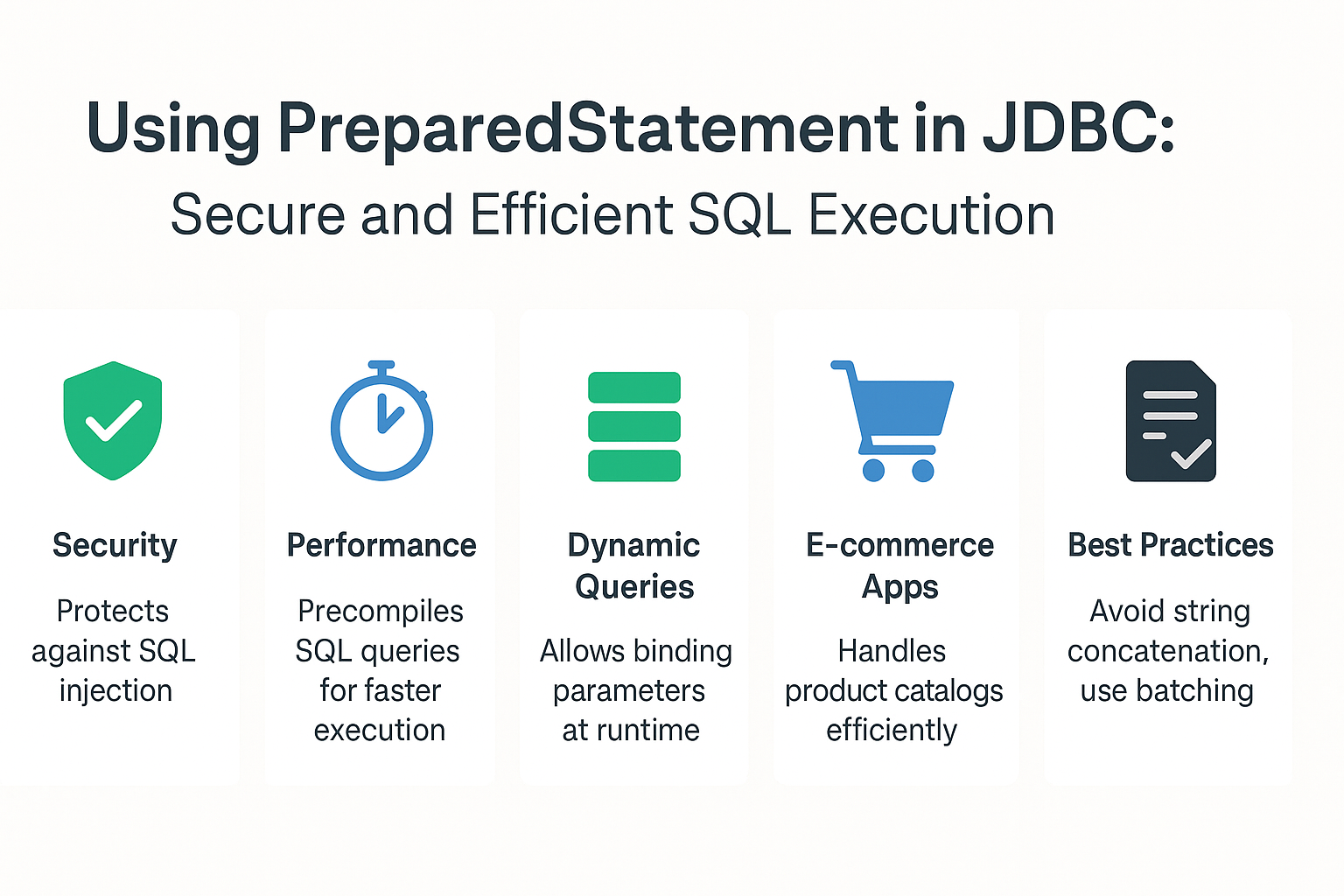Introduction
PreparedStatement in JDBC is one of the most powerful tools for executing SQL queries securely and efficiently. Unlike Statement, it precompiles SQL queries and uses placeholders for parameters, making it ideal for dynamic queries and preventing SQL injection attacks.
Why PreparedStatement Matters
- Security: Protects against SQL injection.
- Performance: Precompiles SQL queries, improving execution speed for repeated queries.
- Flexibility: Allows dynamic parameter binding without changing the SQL structure.
Core Concepts of PreparedStatement
- Parameterized Queries: Use
?placeholders for values. - Precompiled SQL: SQL is parsed and compiled by the database once, then reused.
- Dynamic Binding: Values are bound at runtime, reducing SQL errors.
PreparedStatement Flow
Java App → Connection → PreparedStatement → Parameter Binding → Database → ResultSet
Real-World Use Cases
- User Authentication: Securely validate user credentials.
- E-commerce Apps: Handling product catalogs with dynamic queries.
- Bulk Operations: Efficient inserts and updates using batching.
- Search Queries: Handling user input without risking SQL injection.
Creating and Using PreparedStatement
Step 1: Establish Connection
import java.sql.*;
public class PreparedStatementExample {
public static void main(String[] args) {
String url = "jdbc:mysql://localhost:3306/testdb";
String user = "root";
String password = "password";
String sql = "INSERT INTO employees (name, role) VALUES (?, ?)";
try (Connection conn = DriverManager.getConnection(url, user, password);
PreparedStatement ps = conn.prepareStatement(sql)) {
ps.setString(1, "Alice");
ps.setString(2, "Developer");
int rows = ps.executeUpdate();
System.out.println(rows + " row(s) inserted.");
} catch (SQLException e) {
e.printStackTrace();
}
}
}
Step 2: Executing SELECT Query
String sql = "SELECT id, name FROM employees WHERE role = ?";
try (PreparedStatement ps = conn.prepareStatement(sql)) {
ps.setString(1, "Developer");
try (ResultSet rs = ps.executeQuery()) {
while (rs.next()) {
System.out.println(rs.getInt("id") + " - " + rs.getString("name"));
}
}
}
Statement vs PreparedStatement
| Feature | Statement | PreparedStatement |
|---|---|---|
| SQL Injection Safety | Vulnerable | Safe (uses parameter binding) |
| Performance | Re-parsed on every execution | Precompiled, efficient on reuse |
| Parameters | Hardcoded in query | Uses ? placeholders |
| Batch Support | Limited | Full support |
Common Mistakes and Anti-Patterns
- Forgetting to bind parameters: Leads to SQL errors.
- Using string concatenation: Defeats the purpose of PreparedStatement.
- Not closing resources: Causes memory leaks.
- Using PreparedStatement for single-use queries: Use it for dynamic or repeated queries.
Security Implications
- SQL Injection Prevention: PreparedStatement binds parameters securely.
- Access Control: Use least privilege DB accounts.
- Sanitize Input: Even with PreparedStatement, validate data where necessary.
Performance and Scalability
- Batch Processing: Combine multiple inserts/updates into one execution.
- Connection Pooling: Combine with HikariCP for efficient resource use.
- Reuse PreparedStatements: Cache them for repeated queries in the same session.
Batch Example
String sql = "INSERT INTO logs (message) VALUES (?)";
try (PreparedStatement ps = conn.prepareStatement(sql)) {
for (int i = 0; i < 1000; i++) {
ps.setString(1, "Log entry " + i);
ps.addBatch();
}
ps.executeBatch();
}
Best Practices
- Always use PreparedStatement for user-input queries.
- Use try-with-resources to close automatically.
- Parameterize queries instead of concatenating strings.
- Combine with connection pooling for production environments.
Real-World Analogy
Think of PreparedStatement as a reusable form template. You create the template once (SQL with placeholders) and just fill in the blanks (parameters) whenever you need to submit it.
Conclusion & Key Takeaways
- PreparedStatement is essential for secure and efficient SQL execution.
- Always prefer it over Statement for dynamic queries.
- Use batching and pooling for scalability in production systems.
FAQ
-
What is PreparedStatement in JDBC?
A precompiled SQL statement that supports parameter binding for secure and efficient execution. -
Why is PreparedStatement more secure?
It prevents SQL injection by separating SQL logic from user input. -
When to use PreparedStatement?
For dynamic or repeated queries and whenever user input is involved. -
Can PreparedStatement execute batch queries?
Yes, it fully supports batching. -
Is PreparedStatement faster than Statement?
Yes, especially for repeated queries due to precompilation. -
Do I need to close PreparedStatement?
Yes, use try-with-resources to auto-close it. -
Can I reuse a PreparedStatement?
Yes, you can change parameters and execute multiple times. -
Does PreparedStatement work with all databases?
Yes, all major RDBMS support it through JDBC drivers. -
How to prevent SQL injection in JDBC?
Use PreparedStatement with parameterized queries. -
Which is better: Statement or PreparedStatement?
PreparedStatement for almost all dynamic and secure queries; Statement only for simple, static queries.
